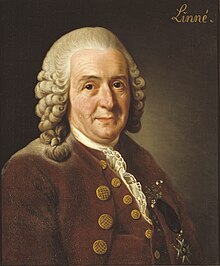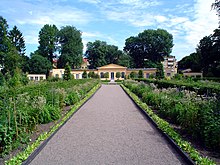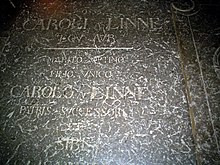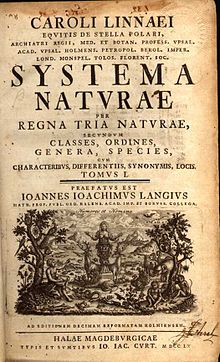Carl Linnaeus
Carolus Linnaeus (Carl von Linné) | |
|---|---|
 Carl von Linné, Alexander Roslin, 1775. Currently owned by and hanging at the Royal Swedish Academy of Sciences. | |
| Born | May 23, 1707 |
| Died | January 10, 1778 |
| Nationality | |
| Alma mater | Uppsala University University of Harderwijk |
| Known for | Taxonomy Ecology Botany |
| Scientific career | |
| Fields | Zoology, medicine, botany |
| Notes | |
Linnaeus adopted the name Carl von Linné after his 1761 ennoblement awarded him the title von. He is the father of Carolus Linnaeus the Younger. | |
Carolus Linnaeus, also known after his ennoblement as , (May 23, 1707 – January 10, 1778), was a Swedish botanist, physician and zoologist[1] who laid the foundations for the modern scheme of nomenclature. He is known as the "father of modern taxonomy." He is also considered one of the fathers of modern ecology (see History of ecology).
He was the most renowned botanist of his time, and also noted for his fine linguistic skills. The French philosopher Jean-Jacques Rousseau sent him the message: "Tell him I know no greater man on earth." [2]; the German writer Johann Wolfgang von Goethe wrote: "With the exception of Shakespeare and Spinoza, I know no one among the no longer living who has influenced me more strongly." [2]; Swedish author August Strindberg wrote: "Linnaeus was in reality a poet who happened to become a naturalist". [3]
Name
The name of this botanist comes in different variants: 'Carl Linnaeus', 'Carolus Linnaeus' and 'Carl von Linné', sometimes just 'Carl Linné'. There is often confusion about his real Swedish name, as opposed to the Latinized form 'Carolus Linnaeus' he used most when he published his scientific works in Latin.
In Linnaeus' time, most Swedes had no surnames. Linnaeus' grandfather was named Ingemar Bengtsson (son of Bengt), according to Scandinavian tradition. Linnaeus' father was known as Nils Ingemarsson (son of Ingemar). Only for registration purposes, for example when matriculating at a university, one needed a surname. In the academic world, Latin was the language of choice, so when Linnaeus' father went to the University of Lund, he coined himself a Latin surname: Linnaeus, referring to a large linden (lime) tree,[4] the warden tree of the family property Linnagård (linn being an archaic form of Swedish lind, the linden). Nils Ingemarsson Linnaeus gave his son the name Carl. So the Swedish name of the boy was Carl Linnaeus.[5]
When Carl Linnaeus enrolled as student at the University of Lund, he was registered as 'Carolus Linnaeus'. This Latinized form was the name he used when he published his works in Latin. After he was ennobled, in 1761,[6] he took the name Carl von Linné. 'Linné' is thus a shortened version of 'Linnaeus', 'von' is added to signify his ennoblement.

When referring to or citing the author Linnaeus, it is appropriate to use 'Carl Linnaeus', 'Carolus Linnaeus' or just 'Linnaeus'. 'Carl von Linné' seems to be less suitable, especially for the works he published before 1762. On the title page of the second edition of Species plantarum (1762) the author's name is still printed as 'Carolus Linnaeus' (or rather the genitive form 'Caroli Linnaei') but from then on, his name is quite consistently printed as 'Carolus a Linne' or 'Carl von Linné'. Stafleu[1] uses 'Carl Linnaeus' as the author's name for all his works.
The adjective of his name is usually 'Linnaean', but the prestigious Linnean Society of London has a journal The Linnean, awards the Linnean Medal, and so on.
Biography
Early life
Carl Linnaeus was born on the farm Råshult, located in Älmhult Municipality, in the province of Småland in southern Sweden, on May 23 1707. He was groomed as a youth to be a churchman, walking in his fathers path, but showed little enthusiasm for it. In 1717 he was sent to the primary school at the city Växjö, and in 1724 he passed to the gymnasium there, but with meager results in the clerical faculty. Instead his interest in botany made an impression on a local physician, realizing there might be a bright future in the field for Carl, and on his recommendation Carl's father sent Carl to study at the closest university, Lund University. Carl studied in Lund and tried to make something of the botanical garden there, but because it had been neglected, it was suggested to him that he would have better prospects at the University of Uppsala; Carl left for Uppsala within a year.[7]
His first time in Uppsala was financially rough, until he was acquainted with the renowned scientist Olof Celsius in 1729. Celsius, impressed with Linnaeus's knowledge and botanical collections, offered him board and lodging.[7]
During this period, he came upon a work which ultimately led to the establishment of his artificial system of plant classification. This was a review of Sebastien Vaillant's Sermo de Structura Florum (Leiden, 1718), a thin quarto in French and Latin. Through this, he became convinced of the importance of the stamens and pistils, on which he in 1729 wrote a short treatise on the sexes of plants. It caught the attention of Olof Rudbeck the Younger (1660-1740), the professor of botany in the university, who subsequently appointed him his adjunct. In 1730, Carl began giving lectures in the faculty.[7]
In 1732 the Academy of Sciences at Uppsala financed Linnaeus on an expedition to Lappland in northernmost Sweden, then virtually unknown. The result of this was first The Florula Lapponica (the first work to use the Sexual System) and later the Flora Lapponica published in 1737. His journey to sub-Arctic Lapland is notable for exotic and adventurous episodes.
He married Sara Elisabeth Morea and had seven children, Carolus, Elisabeth, Sara Magdalena, Lovisa, Sara Christina, Johannes, Sophia.
Travels and research

In 1735 Linnaeus moved to the Netherlands, where he was to spend the next three years. Here he earned his one and only academic degree at the University of Harderwijk in 6 days. This degree in Medicine consisted of a three day printing job of his botanical notes in Latin. He met with botanist Jan Frederik Gronovius and showed him a draft of his work on taxonomy, the Systema Naturae. This was published in the Netherlands the same year, as an eleven page work. [7] Linnaeus stayed put in the Netherlands for 12 months, until he made a journey to London in 1736, where he visited Oxford University and met several highly regarded people, such as the physicist Hans Sloane, the botanist Philip Miller and the professor of botany J. J. Dillenius. The journey lasted a few months, after which he returned to Amsterdam, and continued the printing of his Genera Plantarum, the starting point of his taxonomy.
Heemstede work at Hartekamp

In 1737 Linnaeus spent a year studying and working on the Heemstede garden of George Clifford, a wealthy Amsterdam banker introduced to him by Herman Boerhaave. Clifford had many business connections with Dutch merchants and collected plants from around the world. His garden was famous. Linnaeus published the description of Clifford's garden as 'Hortus Cliffortianus'. In 1738, the work was done, and he started his journey back home. On his way he stayed in Leiden for a year, during which he had his Classes Plantarum printed; then travelling to Paris, before setting sail for Stockholm.[7]
Back in Sweden
Arriving in Stockholm, he settled as a physician in September that year. In 1739 Linnaeus married Sara Morea in Stockholm, and in the same year he was one of the founders of the Royal Swedish Academy of Sciences. In 1741 he ascended to the chair of medicine at Uppsala and moved there. The position was soon exchanged for the chair of botany.[7]
In 1743-44, Linnaeus designed todays centigrade thermometer by reversing the temperature scale (originally 100 was the melting point of ice and 0 water’s boiling point) invented by Anders Celsius (1701-1744) [2]. Throughout the 1740s he conducted numerous field trips to many locations in Sweden to classify plants and animals: in 1741 to the Stora Alvaret on Öland and also to Gotland; in 1746 to Västergötland; and in 1749 to Scania including visits to the Kullaberg. The reports of each travel were published in the Swedish language to be accessible for the general public. Apart from containing many important reports of common life of that time, they have in recent years been appreciated for its fine treatment of the Swedish language, indeed putting Linnaeus as one of the foremost Swedish writers of the 18th century.[9]

When not on travels, Linnaeus worked on his classifications, extending them to the kingdom of animals and the kingdom of minerals. The last may seem somewhat odd, but the theory of evolution was still a long time away. Linnaeus was only attempting a convenient way of categorizing the elements of the natural world.
The Swedish king, Adolf Fredrik, ennobled Linnaeus in 1757, and after the privy council had confirmed the ennoblement Linnaeus took the surname von Linné, later often signing just Carl Linné.
Last years

After his ennoblement, he continued teaching and writing. His reputation had spread over the world, and he corresponded with many different people. For example, Catherine II of Russia sent him seeds from her country.[10]
Of Linnaeus' children, five reached adult age: four girls and one boy. Only the boy, Carolus Linnaeus the Younger, was allowed to study. He did not have the same passion as his father, but managed to make a reputation in botany. At the father's death, the son succeeded him as professor; however, he died only five years later. The son is commonly referred to as filius (abbreviated "L. f.") to distinguish him from his famous father.[10]
Linnaeus last years were troubled by weak health, and he was troubled by gout and tooth aches.[10] A stroke in 1774 greatly weakened him, and two years later he suffered another, losing the use of his right side. He died on January 1778 in Uppsala, during a ceremony in the Uppsala Cathedral. He was buried in the cathedral.[7]
Linnaean taxonomy
Taxonomists, in almost any biological field, have heard of Carolus Linnaeus. His prime contribution was to establish conventions for the naming of living organisms that became universally accepted in the scientific world (binomial nomenclature or binomial names, scientific names): the work of Linnaeus represents the starting point of binomial nomenclature. In addition Linnaeus developed, during the great 18th century expansion of natural history knowledge, what became known as the Linnaean taxonomy; the system of scientific classification now widely used in the biological sciences.
The Linnaean system classified nature within a hierarchy, starting with three kingdoms. Kingdoms were divided into Classes and they, in turn, into Orders, which were divided into Genera (singular: genus), which were divided into Species (singular: species). Below the rank of species he sometimes recognized taxa of a lower (unnamed) rank (for plants these are now called "varieties").
His groupings were based upon shared physical characteristics. Although only his groupings for animals remain to this day, and the groupings themselves have been significantly changed since Linnaeus' conception, as well as the principles behind them, he is credited with establishing the idea of a hierarchical structure of classification which is based upon observable characteristics. While the underlying details concerning what are considered to be scientifically valid 'observable characteristics' has changed with expanding knowledge (for example, DNA sequencing, unavailable in Linnaeus' time, has proven to be a tool of considerable utility for classifying living organisms and establishing their relationships to each other), the fundamental principle remains sound.
Mankind
Linnaeus was also a pioneer in defining the concept of "race" as applied to humans. Within Homo sapiens he proposed four taxa of a lower (unnamed) rank. These categories are, Americanus, Asiaticus, Africanus, and Europeanus. They were based on place of origin at first, and later skin color. Each race had certain characteristics that were endemic to individuals belonging to it. Native Americans were reddish, stubborn, and angered easily. Africans were black, relaxed and negligent. Asians were sallow, avaricious, and easily distracted. Europeans were white, gentle, and inventive. Linnaeus's races were clearly skewed in favour of Europeans. Over time, this classification led to a racial hierarchy, in which Europeans were at the top. Members of many European countries used the classification scheme to validate their conquering or subjugation of members of the "lower" races. In particular the invented concept of race was used to enforce the inhumane institution of slavery, particularly in the new world European colonies.
In addition, in Amoenitates academicae (1763), he defined Homo anthropomorpha as a catch-all race for a variety of human-like mythological creatures, including the troglodyte, satyr, hydra, and phoenix. He claimed that not only did these creatures actually exist, but were in reality inaccurate descriptions of real-world ape-like creatures.
He also, in Systema Naturæ, defined Homo ferus as "four-footed, mute, hairy." It included the subraces Juvenis lupinus hessensis (wolf-boys), whom he thought were raised by animals, and Juvenis hannoveranus (Peter of Hanover) and Puella campanica (Wild-girl of Champaigne). He likewise defined Homo monstrosous as agile and fainthearted, and included in this race the Patagonian giant, the dwarf of the Alps, and the monorchid Hottentot.
Template:Carolus Linnaeus Racial Definitions
Linnaeus' scientifical research took science on a path that diverged from what had been taught by religious authorities. The Lutheran Archbishop of Uppsala had accused him of "impiety." In a letter [3] to Johann Georg Gmelin dated February 25, 1747, Linnaeus wrote:
Non placet, quod Hominem inter ant[h]ropomorpha collocaverim, sed homo noscit se ipsum. Removeamus vocabula. Mihi perinde erit, quo nomine utamur. Sed quaero a Te et Toto orbe differentiam genericam inter hominem et Simiam, quae ex principiis Historiae naturalis. Ego certissime nullam novi. Utinam aliquis mihi unicam diceret! Si vocassem hominem simiam vel vice versa omnes in me conjecissem theologos. Debuissem forte ex lege artis. |
It is not pleasing to me that I must place humans among the primates, but man is intimately familiar with himself. Let's not quibble over words. It will be the same to me whatever name is applied. But I desperately seek from you and from the whole world a general difference between men and simians from the principles of Natural History. I certainly know of none. If only someone might tell me one! If I called man a simian or vice versa I would bring together all the theologians against me. Perhaps I ought to, in accordance with the law of the discipline [of Natural History]. |
Bibliography
Systema Naturae

The first edition of Systema Naturae was printed in the Netherlands in 1735. It was an eleven page work. By the time it reached its 10th edition (1758), it classified 4,400 species of animals and 7,700 species of plants. In it, the unwieldy names mostly used at the time, such as "Physalis annua ramosissima, ramis angulosis glabris, foliis dentato-serratis", were supplemented with concise and now familiar "binomials", composed of the generic name, followed by a specific epithet - in the case given, Physalis angulata. These binomials could serve as a label to refer to the species. Higher taxa were constructed and arranged in a simple and orderly manner. Although the system, now known as binomial nomenclature, was developed by the Bauhin brothers (see Gaspard Bauhin and Johann Bauhin) almost 200 years earlier, Linnaeus was the first to use it consistently throughout the work, also in monospecific genera, and may be said to have popularized it within the scientific community.
Linnaeus named taxa in ways that personally struck him as common-sensical; for example, human beings are Homo sapiens (see sapience). He also briefly described a second human species, Homo troglodytes ("cave-dwelling man"). This was however likely a confusion originating from exaggerated second- or third-hand accounts of the chimpanzee (currently most often placed in a different genus, as Pan troglodytes). The group "mammalia" are named for their mammary glands because one of the defining characteristics of mammals is that they nurse their young.
Species Plantarum
The Species Plantarum was first published in 1753, as a two-volume work. Its prime importance is perhaps that it is the primary starting point of plant nomenclature as it exists today.
Students
Carolus imbued his students with his own thoroughness in an atmosphere of enthusiasm, trained them to close and accurate observation, and then sent them to various parts of the globe. Some of the notable students and expeditions include Pehr Kalm's visit to North America 1748–1751; Daniel Solander, traveling first with James Cook's expedition to the Pacific in 1768, then in 1771 to Iceland, the Faroes and Orkney; Fredric Hasselquist, who visited Palestine and parts of Asia Minor; and Carl Peter Thunberg, journeying to Japan, South Africa, Java, and Sri Lanka.
See also
- Linnean Society of London
- Linnaeus Arboretum
- Jonas C. Dryander
- Peter Artedi
- Sir John Hill. One of Linnaeus' most constant correspondents in England.
- History of phycology
Notes and references
- ^ a b Stafleu, F.A. (1976-1998) Taxonomic Literature second edition. An authoritative work on the names of botanists, their works and publication data, issued under the auspices of the IAPT.
- ^ a b "What people have said about Linnaeus", Uppsala University website "Linné on line" English language version.
- ^ Linnaeus deceased Uppsala University website "Linné on line" English language version.
- ^ Template:Sv icon Lind on Den virtuella floran, by The Swedish Museum of Natural History, accessed on 14 May 2006
- ^ Stearn, W.T. (1992), Botanical Latin, fourth edition: p. 283-284, Timber Press, Portland, Oregon. ISBN 978-0-88192-321-6.
- ^ W.T. Stearn, (1957), An introduction to the Species Plantarum and cognate botanical works of Carl Linnaeus, Principal events in the life of Linnaeus; in: Carl Linnaeus, Species Plantarum, A Facsimile of the first edition 1753, Volume I: 14, Ray Society, London.
- ^ a b c d e f g Encyclopædia Britannica Eleventh Edition, article Linnaeus. Suggested direct-link: [1], accessed September 1. Cite error: The named reference "brit" was defined multiple times with different content (see the help page).
- ^ Sörling & Fagerstedt, p.32
- ^ Algulin, Ingemar, A History of Swedish Literature (1989), p.43
- ^ a b c Uppsala University, Linné Online, English language version
References
- Sörlin & Fagerstedt, Linné och hans lärjungar, 2004. ISBN 91-27-35590-X
- J.L.P.M.Krol, Linneaus' verblijf op de Hartekamp In: Het landgoed de Hartekamp in Heemstede. Heemstede, 1982. ISBN 90-70712-01-6
External links
- Biography at the Department of Systematic Botany, University of Uppsala
- Biography at The Linnean Society of London
